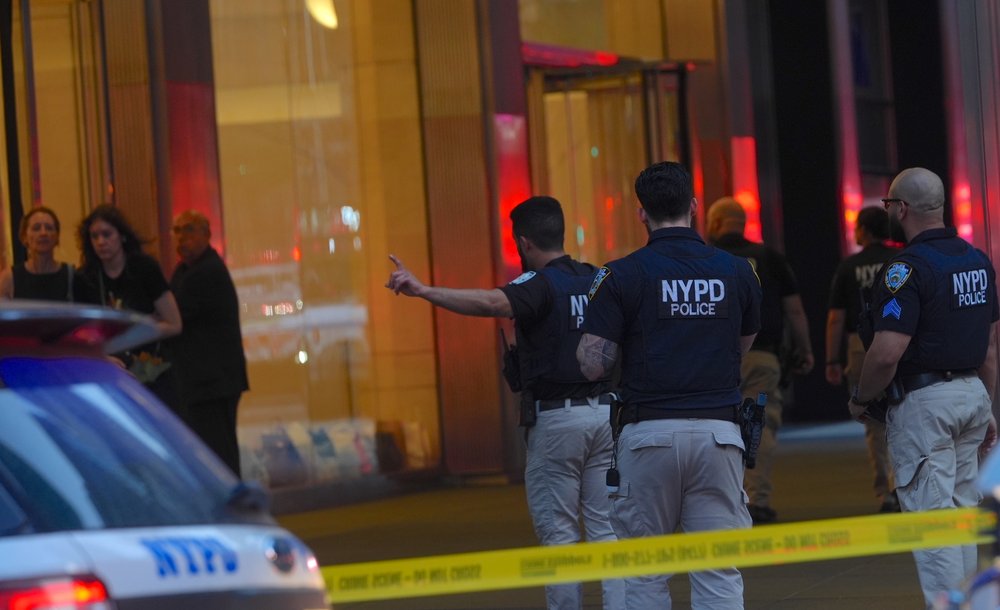Experts differ on how to keep NYC office buildings safe after Midtown shooting
July 30, 2025, 6:01 a.m.
This isn’t the first time buildings have re-evaluated their security measures — and it likely won’t be the last.

A shooting in a Midtown office building on Monday has raised questions about whether any additional security measures could have prevented the violence.
At least one NYPD officer and one security guard were stationed at the Park Avenue skyscraper, which houses offices for the National Football League, Blackstone and other companies. The shooter, Las Vegas resident Shane Tamura, killed both of them, according to police. Officials said Tamura also shot three other civilians — two of them fatally — before killing himself.
Gothamist spoke with security experts about the steps office buildings can take to reduce the risk of violence — and whether this shooting could change the landscape of office skyscraper safety in New York City moving forward.
No perfect solution
Several security experts told Gothamist that office buildings use a wide variety of measures to protect workers and visitors.
“There isn’t any one measure that you can just check the box and feel as if your facility is being protected,” said Brian Higgins, president of the security consulting firm Group 77 and a lecturer at John Jay College of Criminal Justice.
He said some buildings install security cameras to detect a possible threat before someone walks inside, like a person holding a gun. Some require people to pass through multiple sets of doors or a barrier like a turnstile that only opens with permission, he said. Higgins also said some buildings require people to go through airport-style security with a metal detector.
Technology can help minimize risks
Technology has gotten better at flagging weapons, said Anthony Roman, CEO of the investigation firm A.C. Roman and Associates.
“There's an entire new wave of equipment, which can be used to greatly reduce assault risks — weapon-type of assault risks — and prevent or minimize the amount of injuries and deaths suffered in these instances,” he said.
Roman said newer metal detectors that use infrared do a better job of finding weapons or explosives. He said they’re also better at distinguishing between dangerous metal devices and non-threatening personal belongings, like keys.
Roman also said some technology uses artificial intelligence to spot risks outside the building and alert security personnel inside. If the system detects someone with a weapon, he said, a security guard could lock them out or search and disarm them.
But technology isn’t always enough to stop a threat, said Michael Balboni, a former New York state senator who is now the president of security firm RedLand Strategies. He said even an advanced detection system doesn't necessarily give security personnel enough time to lock down the building when someone is walking quickly with a gun.
Security is a balance
The cost of technology and other security measures can be a deterrent for companies and building managers, several experts said. But cost isn’t the only factor when assessing how open or locked down a building should be.
Civil liberties advocates have raised concerns about widespread surveillance and questioned the effectiveness of new technologies. Security measures can also give a false sense of security and distract from the root issues that drive violence, said Vishaan Chakrabarti, an architect who led the Manhattan office at the Department of City Planning after 9/11.
"We can't ask our cities, and our architecture, and our public spaces to be the last line of defense,” he said. “[Root causes of violence] need to be addressed at the source, not in some way where we have to imagine the worst possibility happening on every street, sidewalk and building that we occupy. Because first of all, it's impossible, but second of all, it would destroy everything we cherish about an open society."
Kirk Burkhalter, a retired NYPD detective who now teaches at New York Law School, said security measures can be helpful when someone is afraid of getting caught. But he said no security tool is “foolproof.”
“A person who does not really care if they live or die, if they’re apprehended, I don’t know any measures that are necessarily going to stop them if they have the element of surprise,” he said.
Not the first time buildings have reevaluated security — and not the last
Roman, who has been working in the security sector since 1975, said there are “peaks and valleys” to the number of attacks on office buildings and other institutions over time. But he said the threat level has risen overall since 9/11.
Higgins said he noticed an increased focus on security in 2020, when many buildings started to assign more security officers and lock their exterior doors during widespread protests. He said institutions with connections to Israel have also bolstered their security measures since the start of the war between Israel and Hamas.
But Higgins said the emphasis on security after an attack is often temporary.
“I could almost guarantee you that starting today there is increased level of security in buildings throughout New York and the U.S.,” he said. “When the bill comes due and these shootings don't happen for a few months, then it's going to ebb back again, where security's going to take a back seat.”
An NYPD spokesperson said the department is deploying extra officers to high-profile and commercial areas following the shooting.
Brittany Kriegstein and Ryan Kailath contributed reporting.
Midtown office shooter may have targeted NFL offices in building, Mayor Adams says NYPD officers on paid details are used to confronting hotdog vendors, not gunmen